The Lowdown
Due to its thin profile, the Magic V2 is an incredible conversation piece. Honor’s engineering chops—both in the materials used and in the form itself—are on full display. It absolutely looks like the future and a leap forward in foldable phone hardware design—because it is.
In the Magic V2, Honor has produced shockingly thin foldable hardware, equipped it with a modestly capable camera set for photos and videos, powered it with futuristic battery technology, and sabotaged it with software that will make some want to throw it out of the nearest window.
Overall
Pros
- Amazingly thin hardware with an available vegan leather backing
- Gorgeous displays inside and out
- Competent cameras that will satisfy most users
- Two nano-sim slots
- Speedy Snapdragon 8 Gen 2 processor and plenty of RAM
- A fast charging 66W adapter is included in the box
- Stylus compatibility
- All-day battery life
Cons
- Multitasking is not implemented in a very useful way
- No water or dust resistance rating
- Software is better than previous MagicOS versions but needs more polish
- Not available from Honor in the United States
- May not work with your carrier’s 5G bands
Foldable smartphones and their flip-screen cousins are still newcomers to the market compared to their slab-style forebears. While we in North America are limited to just a few models with this screen style, consumers overseas are treated to a virtual smorgasbord of models from various manufacturers – including the Honor Magic V2 featured in this review.
Honor, once a sub-brand of industrial giant Huawei and now an independent entity, is no stranger to the folding form factor, having produced three different models in the last few years – each improving on the previous with hardware and software refinements that show Honor is learning from experience how to engineer and deliver book-style folding devices that compare favorably with those from their competitors.

The device from this lineage I am covering in this review is the Honor Magic V2, which was introduced at the end of July 2023 and has recently been made available in the United Kingdom, Europe, the Middle East, Africa, and Eurasia.
While that availability is broader than at its introduction, the Magic V2 is still a forbidden fruit for many of the world’s consumers. Let’s find out what they are missing out on.
Unboxing the Honor Magic V2
Folding smartphones are priced at a level that demands a premium experience, starting with the initial hands-on experience. Here, the Honor Magic V2 does not disappoint.
The packaging is quite large, with a width double that typical of most other devices. Finished in a luxurious-feeling linen texture with “Honor Magic V2” printed in silver foil, the clamshell box opens to reveal the device in its open state, wrapped in a protective sleeve with handling instructions and warnings regarding the fragility of the inner display.
Underneath are boxes containing the sim tray tool, quick-start guides, USB Type-A to USB Type-C charging cable, a thin and attractive case with a kickstand, and a 66W SuperCharge quick charger.
In an era where many manufacturers skimp on packaging design, quality, and included accessories, it is encouraging to see Honor deliver a promising first impression.
A Hardware Tour of the Honor Magic V2
Nearly without fail, when first taking in a new phone, my eyes are drawn to the main display as it is its most dominant feature. My first hands-on with the Honor Magic V2 was a different story, however, as the visual story of this foldable starts with a remarkably thin profile.
It’s not hyperbole to say that even the most jaded technology enthusiast will pick their jaw off the floor after witnessing this device’s minimal thickness in person.
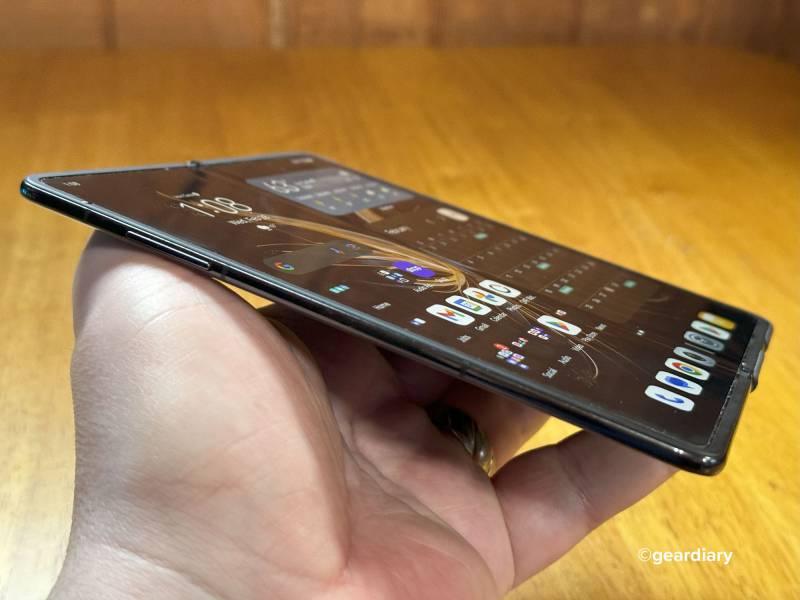
The Honor Magic V2 is a mind-blowing 4.5mm (0.18″) thick (err…thin) unfolded. In comparison, the Honor Magic Vs, a foldable launched less than a year before the Magic V2 in China, scales in at 6.1mm (0.24″) thick when unfolded. That’s nearly a thirteen percent difference.
A contemporary of the Magic V2, the Samsung Galaxy Z Fold 5 also measures 6.6mm (0.26″) thick unfolded. The OnePlus Open measures in at 5.84mm (0.23″) thick unfolded. The Pixel Fold, a device Google touted as the “World’s Thinnest Foldable” when it launched, is also 6.35mm (0.25″) thick unfolded.
Being thin when unfolded also translates to a slim profile when folded for the Magic V2, which comes in at 9.9mm (0.39″). For comparison, a Samsung Galaxy S24 Ultra clocks in at 8.6 mm (0.39″). The iPhone 15 Pro Max? It’s 8.3 mm (0.33″).
Some of the Magic V2’s slimness can likely be attributed to its lack of wireless charging. Including wireless charging coils increases the device’s thickness and introduces some thermal challenges —- challenges Honor avoids by simply not including the feature.
Honor has also not included a rating for dust or water resistance. Folding phones are already known for being a bit on the fragile side. The lack of an IP rating just adds to the worry of carrying a $2,000 phone whose folding party trick is also its Achilles’ Heel.
Yes, the Honor Magic V2 is still a bulky device compared to some of the notable candybar-style flagship phones. This is, however, the first time that using a foldable phone hasn’t felt like an unacceptable compromise. That is to say, the slim size of the Magic V2 is game-changing beyond numbers and benefits real-world usability.
The displays of the Magic V2 fall squarely in line with its competitors in scale and specifications. The flat outer display is a 6.43″ OLED with LPTO support for a dynamic refresh rate of up to 120Hz and a peak brightness of 2500 nits.
The interior display is an expansive 7.92″ with a screen-to-body ratio of about 88 percent. For reference, that’s approaching iPad Mini-levels of display size.
It’s an OLED screen with LPTO support for a dynamic refresh rate of up to 120Hz and a peak brightness of 1600 nits. Each display’s pixel density comes in at about 402 ppi.
The front and interior displays have a punch-hole front-facing camera and are subjectively gorgeous, whether viewed indoors or out. They also have dynamic refresh rate support that will adjust to suit how the user is using it to potentially conserve battery life.
I did not experience dropped frames or stuttering when using the Magic V2 displays. I found the color reproduction to be visually pleasing if over-saturated compared to something like the Google Pixel series’ “natural” display setting.
It’s worth noting that the device supports a Bluetooth stylus dubbed the Magic-Pen, which Honor offers in its home market of China but does not include as an accessory.
The Honor Magic V2 aspect ratios for the exterior display at 20:9 and the interior display at 9.78:9; when closed, it feels comfortably close to that of a typical smartphone and, when open, is nearly square and a happy compromise between the narrow Z Fold series from Samsung and the wide-boy Pixel Fold from Google.
It is most similar to the near-twin foldables from the BBK Electronics Group — the OnePlus Open and Oppo Find N3 — and in my average-sized-man hands, it feels the best choice for use when open or closed.
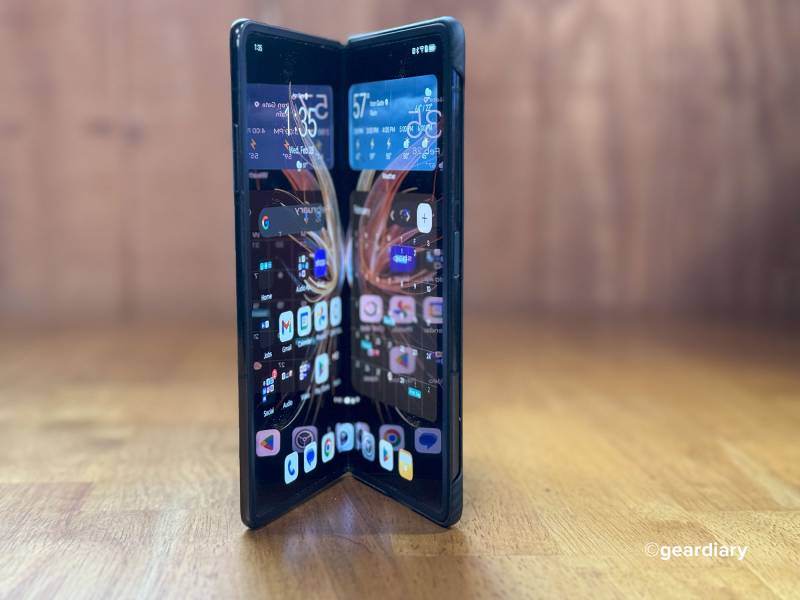
Honor has given the Magic V2 frame subtly curved edges that, when open, have a pleasant enough hand feel and, when closed, create a small valley between sides that helps fingers find grip and support, making it easier to open.
The power button doubles as a fingerprint reader for unlocking the phone, and the volume rocker falls easily within reach of my thumb and pointer finger when closed. Both are positive and clicky in a way that speaks to the quality expected of a device of this tier.
It is clear that Honor has put some thought into the ergonomics of the Magic V2, but I wish they had also included an in-display fingerprint unlock for the cover screen. Doing so might have been quite the engineering challenge with a device that has clearly prioritized thinness. I think it is an acceptable compromise.
The Honor Magic V2’s chassis is composed of a magnesium alloy, a material generally chosen for its weight savings as it is 33 percent lighter than aluminum. It is, however, softer than aluminum, or steel for that matter, and it will be interesting to see how the Magic V2 holds up over the long term.
The hinge mechanism is made of a titanium alloy and opens and closes with a reassuring and progressive resistance that peaks near the halfway point of travel.
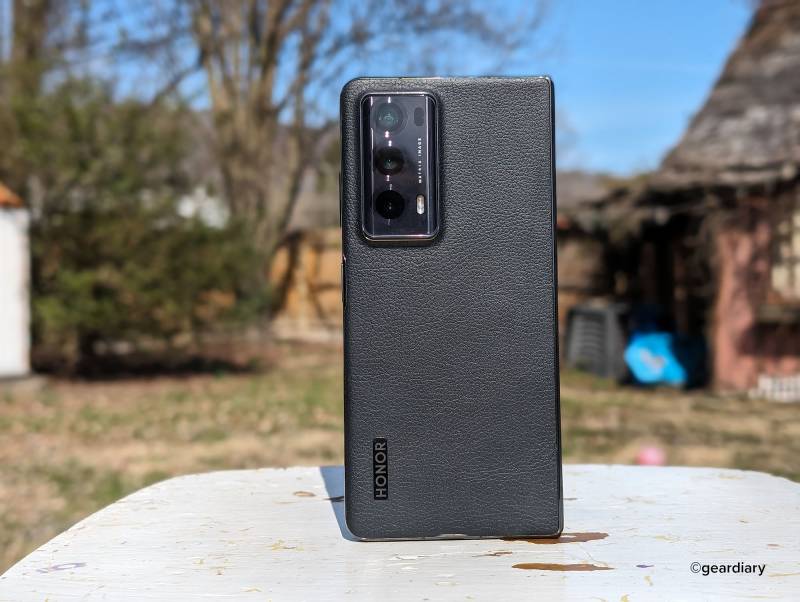
The Honor Magic V2 is available in two colors and finishes outside China – Phantom Purple, equipped with a hardened glass back, and the Midnight Black colorway I received featuring a soft-touch vegan leather back.
While it is unconvincing as a true leather substitute, it substantially aids in grip when compared to a slippery glass alternative and is also more resistant to finger grease.
The Magic V2 comes to 2024 with last year’s top-of-the-line Qualcomm SOC, the Snapdragon 8 Gen 2 built on TSMC’s 4nm production process and pairs it with a more-than-ample 16GB of RAM.
While not the most powerful chipset available, the 8 Gen 2 is still very much a powerhouse of a processor and graphics unit with its Adreno 740 GPU.
It zipped through every task I asked it to perform with aplomb and is quite capable of playing today’s most demanding mobile games without breaking a sweat. It is also quite efficient, helping me get through two days of normal use without a need to top up the battery.
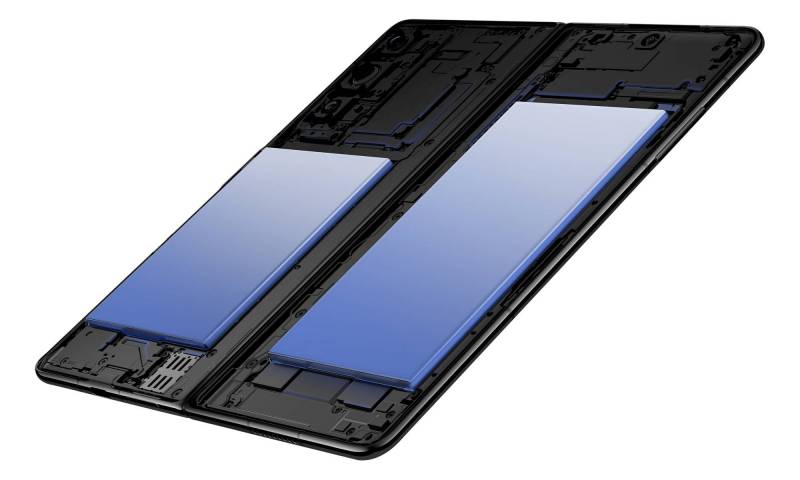
The battery, or batteries, of the Honor Magic V2, merit their own discussion. Each side of the device features an extremely thin 2.7 mm (0.11″) Si-Ca battery, which together add up to a 5,000 mAh capacity.
Honor pioneered the use of Silicon-Carbon batteries in some of their most recent devices – first with the Magic 5 Pro. Si-Ca batteries are denser than battery chemistries found in competing devices and recharge faster as well.
The shockingly thin nature of this foldable is owed much to the benefits of investing in this battery tech. The Magic V2 charges via an included 66W adapter and goes from zero to full in the space of about an hour in my use.
It’s good that the charger is relatively fast, as the Magic V2 does not have the wireless charging of some of its competitors, like the Google Pixel Fold and Galaxy Z Fold 5.
Battery life with the Magic V2 is an all-day affair in my use. This means that after an overnight charge, the foldable’s battery lasted through a day of web browsing, music, video streaming, telegram chats, and light gaming with about twenty percent to spare when I put it back on the charger around 10:00 PM.
Honor Magic V2 Software
As impressive as the fit, finish, and engineering of the Magic V2 is, it is conversely let down by its overwrought, bloated, and, at times, irritating software experience.
The device ships with Honor’s MagicOS 7.2, based on Android 13, with a promised four years of OS updates and five years of security updates. I am glad to report that Honor has made progress in better preparing its version of Android to suit Western audiences.
I did not encounter memorable, poorly translated verbiage in its onboarding process, notifications, or in its core app experiences.
Aside from the fact that MagicOS continues to shout everything at the user with system notifications always presented in all-caps, it felt more like a “normal” Android experience than that of previous Honor devices I’ve reviewed.

It appears that Honor was “inspired” by Samsung in its software design and approach. Onboarding from first power on, Honor prompts you to create an Honor ID account to sign into Honor Connect – which serves as its portal for their services.
I presume it would be an advantage if you were to buy into their ecosystem of accessory devices like smartwatches, headphones, and Microsoft Windows-based laptops offered in its home country.
Again, like Samsung, MagicOS installs its own apps that duplicate the function of those offered by Google, including a separate app store. While this makes sense in China, where Google apps and services are not available, it serves mostly as an annoyance to anyone who has spent years on an Android device and is heavily invested in Google’s ecosystem.
This duplication is exacerbated by an inability to delete Honor’s apps like Phone or Contacts. Those who use Microsoft services will find a few items to like in Magic OS 7.2, with Phone Link integrated into the software rather than with an app install, while SwiftKey continues to be Honor’s default virtual keyboard of choice.
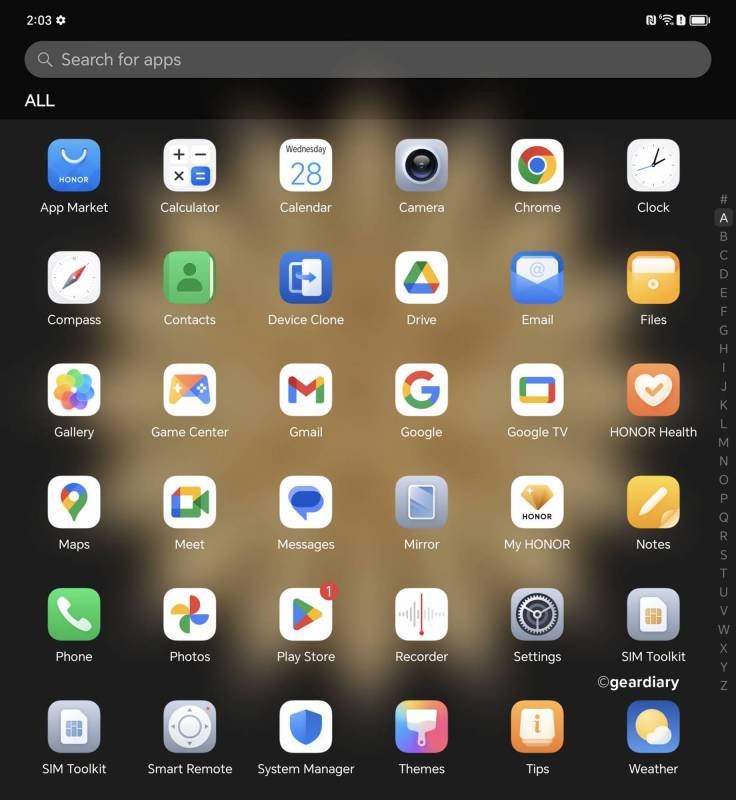
MagicOS’s process management aggressively shuts down third-party apps at times, even if they have been given carte blanche permission to run in the background. This led to the app that my smartwatch uses having to be relaunched several times during the day and killing its sync functionality.
This is more of a frustration than a deal-breaker and is not an issue limited to Honor devices. I have had a similar experience with smartphones from Xiaomi and OnePlus.
Where Honor could most thoughtfully improve MagicOS in a manner specific to foldables is in the way it approaches multitasking. Every time I switched from the front display to the inner screen or the reverse and opened an app in memory, I was prompted by the system to relaunch the app.
If this is necessary, I think it would be better for Honor to simply automate it rather than the system nagging the user with a notification that feels more like a disclaimer.
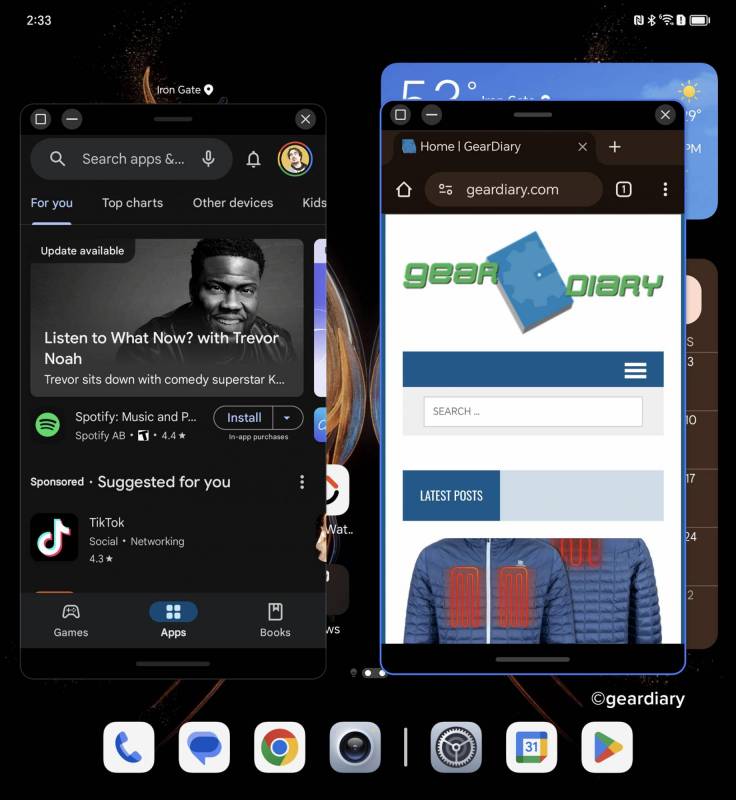
It is possible to use two apps side by side while the device is in its open position. Unfortunately, the apps float in individual instances above the home screen. It feels like a half-hearted attempt at a desktop operating system, complete with actionable buttons for closing the app or making it fullscreen.
It is impossible to tile them in the way OnePlus and Samsung offer on their foldable devices, making the apps feel less immersive and less usable.
This is made all the more frustrating given the thin design of the Magic V2, which makes it so physically easy to hold and use the device unfolded – and the result is sometimes a fundamental disconnect between the hardware and software.
Honor Magic V2 Cameras

Honor continues to deliver a camera experience with its high-end devices that deliver results from competent to quite good.
The Magic V2’s rear camera module houses a wide-angle camera with a 50-megapixel sensor, a f/1.9 aperture, and optical image stabilization; a telephoto camera with a 20-megapixel sensor, 2.5X optical zoom, a f/2.4 aperture, and optical image stabilization; and an ultra-wide camera with a 50-megapixel sensor and f/2.0 aperture.
The inner and cover displays offer a selfie wide-angle camera with a 16-megapixel sensor and a f/2.2 aperture. The main camera set can record video at 4K at 60 fps, while the front-facing cameras are limited to 1080p at 60 fps.
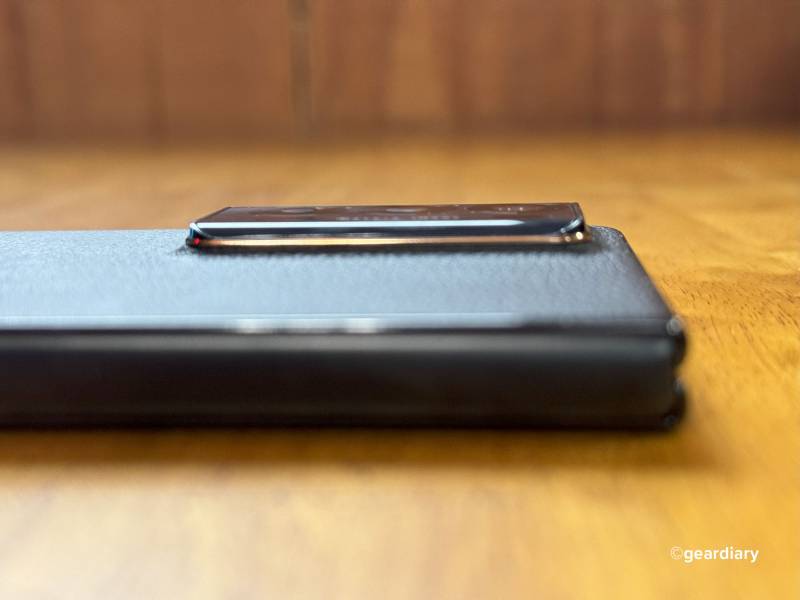
As always, hardware specs tell only part of the story. Like most smartphones, the Z-axis depth for these large sensors makes for a large camera hump on the rear of the device.
I believe this is made even larger by the thin body of the Magic V2. Compromises for thinness had to be made, resulting in a very wobbly smartphone resting on a flat surface.
Honor’s camera app is feature-rich with a bit of a learning curve. It includes a Pro mode that will please those who enjoy having manual control over the ISO, shutter speed, white balance, and the ability to save photos in JPG-L or RAW formats.
I used the Honor Magic V2 on a road trip that ended with a live concert to test its photo and video capabilities in challenging environments. I was quite happy with many of the photos I took with the wide-angle and telephoto cameras and marginally less so with the ultra-wide camera.
In less-than-perfect lighting situations, I got very usable photos while enjoying a few craft cocktails with my wife.

While sitting about seven rows from the stage during the concert, I captured photos using the telephoto and ultra-wide cameras that were social media-usable – if not something I would preferably hang on my wall at home.
The Magic V2 struggled to capture a crisp picture of the troubadour playing the guitar at maximum optical zoom using the telephoto camera.
I must reiterate that this was a very challenging environment for any smartphone camera, with the overhead lights on stage changing frequently, causing the device to have to make metering decisions and more with what was an ever-changing target.
The video I captured at the concert was also good, minimizing the shake from my hands, producing rich colors that closely matched what I saw with my eyes, and recording audio that sounded lifelike and without distortion despite being close to overhead PA speakers.

The Honor Magic V2’s selfie cameras produced acceptable results with mostly accurate colors, struggling mostly in photo and video captures when an especially bright light source produced flares on the lens that appeared to make the software processing unsure of exactly what settings to use.
The results were consistent between the inner display and cover display selfie cameras, for better and worse.
While the Magic V2 is not what I consider a camera-focused phone, I believe most of those who purchase this foldable will be quite satisfied with the images and video they can produce with its cameras.
Final Thoughts on the Honor Magic V2
For those considering importing the Honor Magic V2, using the device on T-Mobile’s network, I was able to connect to 5G or 4G LTE in southwestern Virginia. It does not support T-Mobile’s 5G UC, which is where the highest speeds reside.
Due to its thin profile, the Magic V2 is an incredible conversation piece. Honor’s engineering chops—both in the materials used and in the form itself—are on full display. It absolutely looks like the future and a leap forward in foldable phone hardware design—because it is.
In the Magic V2, Honor has produced shockingly thin foldable hardware, equipped it with a modestly capable camera set for photos and videos, powered it with futuristic battery technology, and sabotaged it with software that will make some want to throw it out of the nearest window.
At $2,000 US, I find it hard to recommend when there are foldables that offer a more polished experience and longer software support for less money.
The Honor Magic V2 sells for €1,999.90 or £1699; outside the US, it is available directly from the manufacturer. In the US, it is available from various resellers, including eBay, DHgate, and Ali Express.
Source: Manufacturer supplied review sample
What I Like: Amazingly thin hardware with an available vegan leather backing; Gorgeous displays inside and out; Competent cameras that will satisfy most users; Two nano-sim slots; Speedy Snapdragon 8 Gen 2 processor and plenty of RAM; A fast charging 66W adapter is included in the box; Stylus compatibility; All-day battery life
What Needs Improvement: Multitasking is not implemented in a very useful way; No water or dust resistance rating; Software is better than previous MagicOS versions but needs more polish; Not available from Honor in the United States; May not work with your carrier’s 5G bands

Be the first to comment on "Honor Magic V2 Review: An Incredibly Thin Foldable Phone Held Back by Half-Baked Software"